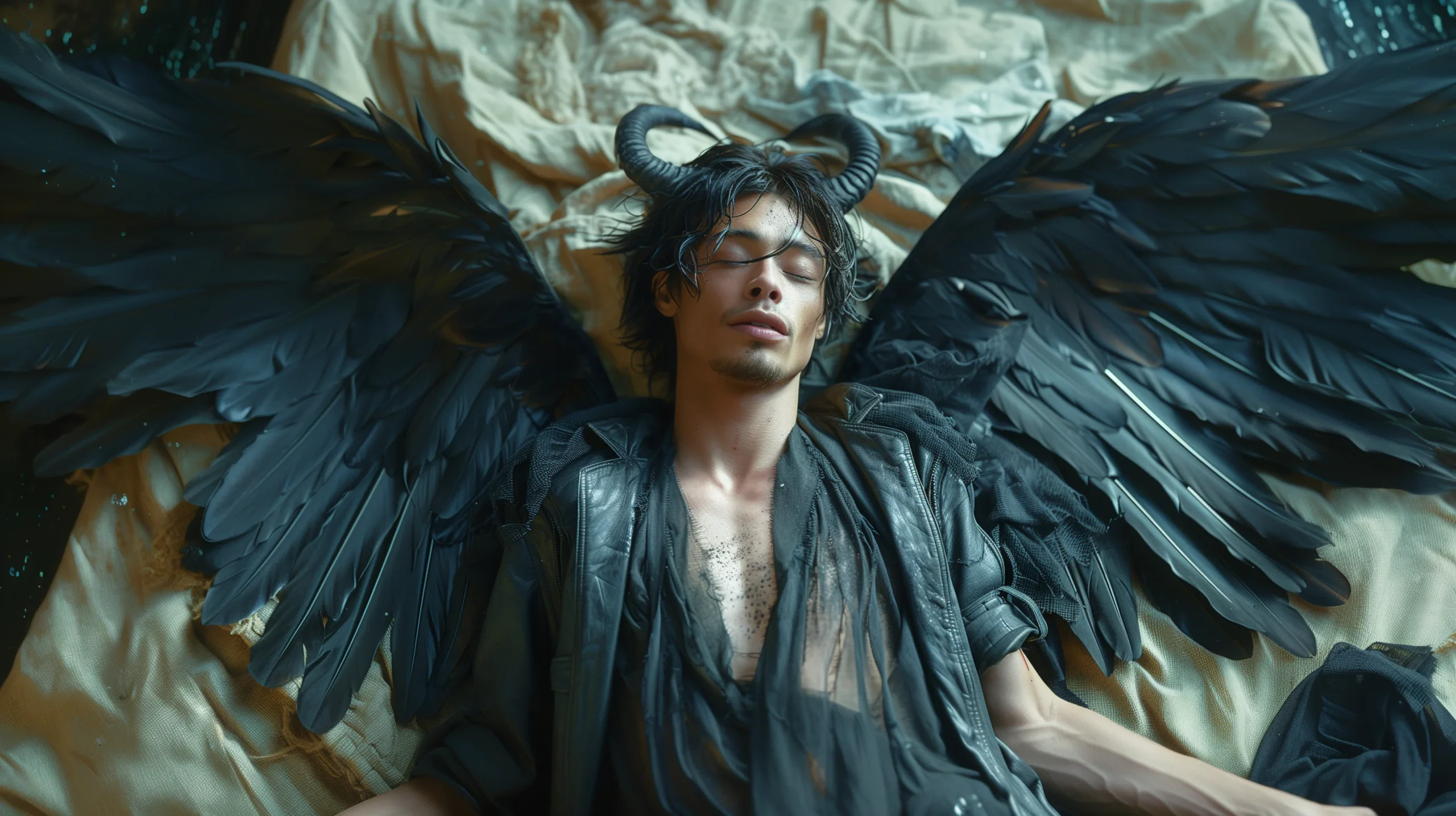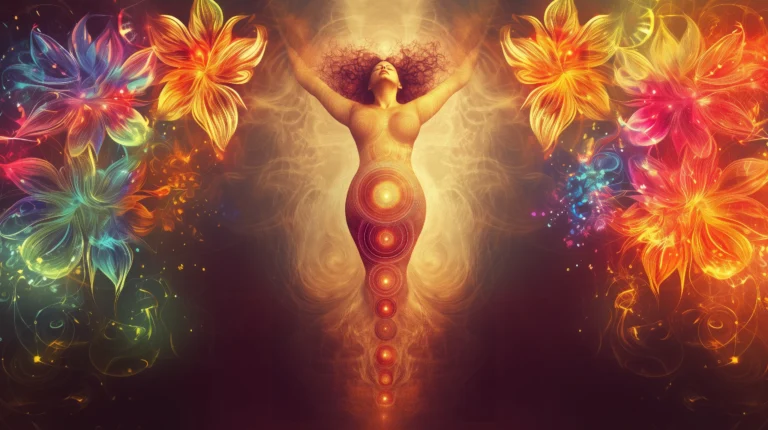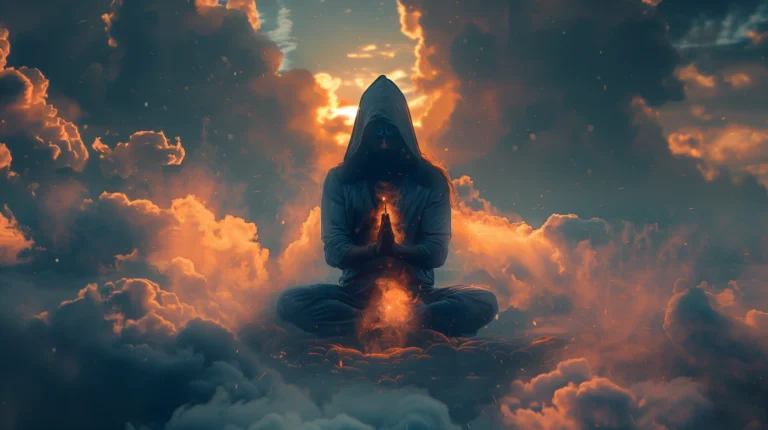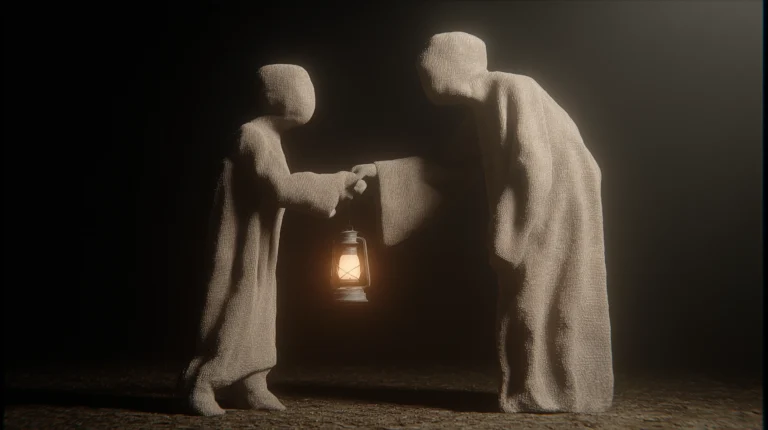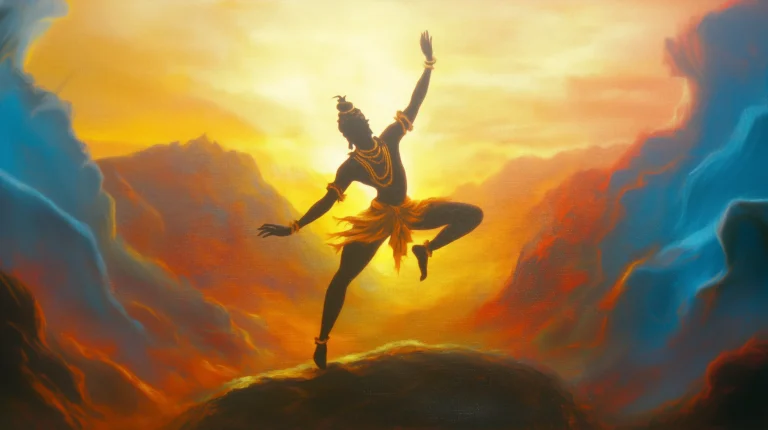The Alchemy of Spirit: Uniting Samael and Michael Within
Preface
“The serpent said to the woman, “You surely will not die! For God knows that in the day you eat from it your eyes will be opened, and you will be like God, knowing good and evil.
Genesis 3:4-5
In the journey of life, we often find ourselves at the crossroads of the seen and the unseen, the known and the unknown. This guide is an exploration of those boundaries, a voyage into the depths of human consciousness, and an invitation to reconsider the fabric of our existence. Through the lens of ancient wisdom, modern psychology, and the timeless questions that have puzzled humanity, we will embark on a quest to uncover the truths that lie hidden beneath the surface of conventional understanding. In the words of Lao Tzu.
“At the center of your being you have the answer; you know who you are and you know what you want.”
The chapters within this guide are not merely a collection of thoughts but a tapestry woven from the threads of human experience, philosophical inquiry, and spiritual introspection. We will delve into the complex nature of Samael, the Angel of Death, in order to illuminate the path towards self-awareness and transformation. We will explore the concept of THE ALL as SPIRIT, navigating the realms of synchronicity in order to understand how the universe communicates with us in mysterious yet meaningful ways.
In discussing the notion of life as a societal hoax, we challenge the predefined paths laid before us, urging a reevaluation of what it means to live authentically and purposefully. We will examine the dualistic nature of divinity through the prism of Abraxas, to grasp the unity of opposites and the intricate dance between light and shadow. As stated by Carl Jung.
“The privilege of a lifetime is to become who you truly are.”
As we navigate the chapters of this guide, let us remember that the journey is as important as the destination. The insights and understanding we seek are not always found in the answers but in the willingness to explore the questions. In the end, it is our quest for knowledge, self-understanding, and connection to the SPIRIT that defines our journey through life. Quoting André Gide,
“Man cannot discover new oceans unless he has the courage to lose sight of the shore.”
Welcome to a journey of discovery, transformation, and enlightenment. Welcome to the exploration of the infinite within.
The Story of Samael
Samael’s name means “Venom” or “Poison of God.” Samael stands as an enigmatic figure in Talmudic traditions and beyond. This archangel, often likened to the concept of Satan in Christian theology, serves a complex role that transcends the notion of evil. Samael’s duties, which include the elimination of sinners, position him as a force of divine justice rather than malevolence. He is recognized as the supreme angel of death and a leader among adversarial forces, yet he operates as a servant of the Divine Will. Samael’s essence transcends the mere label of malevolence; his actions encompass a broader spectrum of divine intention, portraying him as a harbinger of both retribution and necessary change.
Traditionally viewed as the sovereign of demons, the consort of the demoness Lilith, and the formidable opponent of the archangel Michael and Israel, Samael embodies a multifaceted nature. Associated with Mars, the northern direction, and the day Tuesday, uttering his name is avoided to prevent invoking his attention.
It’s crucial to address the often misunderstood term “demon.” The modern connotation of demons, fraught with negative imagery and fear, strays far from its original meaning. Tracing back to its roots, the word “demon” originates from the Latin “daemon,” which itself comes from the Ancient Greek “δαίμων” (daimōn), signifying a “genius” or “guardian spirit.” This term historically referred to a dispensing or protective spirit, one that offers guidance, wisdom, and protection, rather than the malevolent beings popular culture and religious dogma have painted them to be. For more details on this, please consider checking out our other book titled ‘Unveiling the True Nature of Demons: Magic and Spiritual Enlightenment.‘ Now, moving forward.
As guardian angel and prince of Rome, he is the archenemy of Israel. By the beginning of Jewish culture in Europe, Samael had been established as a representative of Christianity, due to his identification with Rome. This connection underscores a pivotal narrative: the emergence of Jewish culture within Europe and the intertwining of religious identities, where Samael came to symbolize the complex interplay between Judaism and the rising influence of Christianity.
Attributions to Samael within Jewish history are varied and profound, including significant actions that shaped humanity’s spiritual narrative. Despite these associations, in earlier Jewish texts, Samael’s identity diverges from the later portrayal as the “head of satans,” reflecting a complex evolution from guardian angel to a symbol of opposition.
In Gnostic thought, Samael’s character undergoes a fascinating evolution, diverging markedly from his Jewish portrayal. Here, he is intertwined with the Demiurge—a concept depicting the creator of the material world, often viewed as a source of ignorance and spiritual blindness. The Gnostic texts, including the Apocryphon of John and On the Origin of the World, introduce Samael as a figure of profound misunderstanding, calling him a “blind god.” This depiction mirrors the attributes traditionally ascribed to the Christian devil, emphasizing deception and a lack of divine insight.
The Kabbalistic tradition offers another layer to Samael’s narrative, describing him as the embodiment of God’s severity. Positioned as one of the archangels in the world of Briah, Samael oversees realms associated with conflict and destruction, such as the destiny of Esau and the domain of demons. His union with Lilith, a figure of darkness and rebellion herself, marks a significant thematic development. Together, they are portrayed as producing offspring that challenge the divine order, highlighting themes of unchecked power and spiritual defiance.
Their relationship, further explored in the Kabbalistic “Treatise on the Left Emanation,” presents Samael and Lilith as dark mirrors to the primordial couple, Adam and Eve. This pairing, emanated from the Throne of Glory, encapsulates the intricate balance between creation and destruction, purity and corruption. The narrative of their forced separation by divine intervention—meant to prevent the proliferation of demonic beings—speaks to the ongoing struggle between celestial and infernal forces.
Descriptions of Samael include him having extraordinary features: he can fly with 12 wings, has a unique appearance with fiery eyes, horns, and is extremely tall. There’s a mention of him having a single long hair that will bend at the sound of a shofar, signaling the start of a messianic era.
Samael’s portrayal as the angel of death and a commanding presence in the heavenly realms further illustrates his significance across spiritual narratives. His role encompasses the administration of divine justice, the transition of souls, and the embodiment of necessary transformation.
In mystical accounts, such as the “Apocalypse of Moses,” Samael’s formidable presence is highlighted, representing the inevitability of death and the divine judgment. This narrative, alongside others, paints a picture of Samael as a pivotal figure in the spiritual cosmos, serving as a reminder of the complex interplay between light and darkness, order and chaos, within the fabric of existence.
According to apocryphal, The Apocalypse of Moses,
There was another angel in the seventh heaven, different in appearance from all the others, and of frightful mien. His height was so great, it would have taken five hundred years to cover a distance equal to it, and from the crown of his head to the soles of his feet he was studded with glaring eyes. “This one,” said Metatron, addressing Moses, “is Samael, who takes the soul away from man.” “Whither goes he now?” asked Moses, and Metatron replied, “To fetch the soul of Job the pious.” Thereupon Moses prayed to God in these words, “O may it be Thy will, my God and the God of my fathers, not to let me fall into the hands of this angel.”
This multifaceted portrayal of Samael, spanning from his origins in Jewish lore through the Gnostic reinterpretations and Kabbalistic teachings, reveals a character of unparalleled complexity. Samael stands not merely as an agent of destruction but as a necessary force within the divine narrative, facilitating transformation, enforcing divine justice, and reflecting the profound ambivalence at the heart of spiritual understanding.
Confronting the Shadow of Death
In exploring the multifaceted nature of Samael, the Angel of Death, we venture into the depths of human consciousness and the existential fear that accompanies the awareness of mortality. This journey is not just about understanding a figure from ancient texts but also about delving into the human psyche’s response to the inevitability of death.
Ernest Becker’s seminal work, “The Denial of Death” (1973), offers a critical lens through which to examine how this fear influences human behavior and societal structures. By weaving together the mythos of Samael with Becker’s insights, we can unravel the complex ways in which humanity copes with the knowledge of its finitude.
Ernest Becker posited that the fear of death is a fundamental driving force behind human actions. He argued that much of human civilization, its cultures, and achievements, are part of an elaborate defense mechanism against the knowledge of our mortality, which he termed “terror management.” According to Becker,
“The idea of death, the fear of it, haunts the human animal like nothing else; it is a mainspring of human activity—activity designed largely to avoid the fatality of death, to overcome it by denying in some way that it is the final destiny for man.”
Samael, as the Angel of Death, embodies the terror that Becker speaks of. In myths and religious texts, Samael is not merely a bringer of death but also a symbol of the knowledge of our end, the understanding of which is said to have originated from the very act that led to humanity’s fall from Eden. This knowledge imbues Samael with the power not just over the physical act of death but over the existential dread that accompanies it.
However, Becker offers a path forward through his exploration of the hero’s journey, a concept that mirrors the struggle against the shadowy figure of Samael. He suggests that by heroically confronting the reality of death, individuals can transcend their fear. He wrote,
“To live fully is to live with an awareness of the rumble of terror that underlies everything.”
In this light, Samael’s presence challenges us to confront our deepest fears and, in doing so, to find a way to live more authentically.
Becker also illuminates how cultures and religions create symbols and narratives, like those surrounding Samael, to manage the terror of death. These myths serve as a collective attempt to deny the finality of death, either by promising an afterlife or by portraying death as part of a larger, meaningful cosmic plan. Becker explained,
“Man cannot endure his own littleness unless he can translate it into meaningfulness on the largest possible level.”
In confronting Samael, or the concept of the Angel of Death, we are also confronting our own constructed narratives around death and the mechanisms we employ to deny its impact on our lives. This confrontation is not a battle to be won but an acceptance of reality that can lead to a more profound appreciation of life. By acknowledging and facing our fears, as represented by Samael, we open the possibility of transcending them.
Through the lens of Ernest Becker’s theories, we see that Samael, as a figure embodying death and fear, prompts an essential human endeavor. This endeavor is not about conquering death but about understanding its role in giving life meaning and motivating us to live in ways that confront, rather than deny, our mortality. In doing so, we can find a form of psychological and spiritual ascendance, transforming our terror of death into a driving force for a life lived with depth, purpose, and courage.
Complex Nature of God
In the exploration of Samael’s role within Abrahamic religions as the executor of God’s more daunting tasks, it becomes essential to understand the underlying reasons for the existence of such a figure. This necessity leads us to Carl Jung’s insights in his “Seven Sermons to the Dead,” specifically the discussion around Abraxas and the integration of opposites within the divine principle.
Carl Jung’s exploration of Abraxas provides a profound framework for understanding the necessity of entities like Samael in religious narratives. Abraxas symbolizes the unity of all opposites, encompassing both good and evil, existence and non-existence. This figure stands as a testament to the complexity of the divine, surpassing the dualistic separation of God and the Devil found in traditional abrahamic religions. Abraxas is the embodiment of the totality of the divine, representing a deity that is both creator and destroyer, benevolent and wrathful.
The concept of Abraxas challenges the human tendency to categorize the divine as wholly good or evil. It suggests that the divine essence is a union of contradictions, a complex interplay between creation and destruction, love and wrath. This understanding resonates with the figure of Samael, who, despite often being cast in a negative light, serves essential functions within the divine order. Samael’s role as the Angel of Death and the executor of God’s harsher judgments reflects the necessity of balancing forces within the universe.
Before proceeding further, let’s examine the first and second sermons in order to gain a clearer understanding of the concept.
The first sermon
The first sermon begins with a gathering of spirits in Jung’s house, disturbing him from his sleep. These spirits were lost in confusion after death, seeking answers.
In response, Jung delivers his first sermon, speaking about the Pleroma and the principle of the opposites.
The Pleroma: This term is borrowed from Gnosticism and essentially means “fullness” or “wholeness”. In Jung’s sermon, Pleroma is described as a state of complete emptiness and fullness. It is everything and nothing at the same time, a void that is also the origin of all existence. Jung argues that we come from the Pleroma and return to it after death. It’s a state where opposites cease to exist because they cancel each other out.
Principle of the Opposites: Jung emphasizes that the world as we know it exists because of differentiation from the Pleroma, and that differentiation is characterized by the opposites. Everything we perceive is based on the contrast of opposites. For instance, we can only perceive light because we know what darkness is.
Jung also suggests that human desire for unity or the ‘God’ within us is what draws us back to the Pleroma. However, he warns that the undifferentiated state is not preferable while we are alive because it is equivalent to death. The goal, instead, is to acknowledge and balance the opposites within us without being consumed by any one side.
These are complex metaphysical and psychological concepts, and the first sermon serves as a foundational explanation that helps inform the ideas presented in the rest of the sermons. Understanding it may require deep reflection and multiple readings.
The second sermon
In the second sermon of the “Seven Sermons to the Dead,” Carl Jung delves deeper into the principles introduced in the first sermon. He discusses the concept of Abraxas, a Gnostic god, in an attempt to provide an image for the unified divine principle that holds both the opposites.
Abraxas, in Jung’s sermon, is presented as a higher value or god than the Christian God and devil. Abraxas is the entity that combines all opposites into one being. He embodies both existence and non-existence, good and evil, light and dark, the perceptible and the imperceptible. Abraxas is not to be worshipped, but understood as the representation of the unbearable paradox for the human mind – the union of all opposites.
Jung then delves into the concept of God’s “emanation,” a term used in Gnostic literature to describe the process through which the divine principle unfolds into the manifest universe. He portrays the divine as a process of becoming rather than a fixed entity.
Jung also suggests that the world of appearances, which we take as reality, is just an illusory creation. The true reality is incomprehensible and can only be vaguely intuited.
He talks about the power of love and its association with death. Love, in this sermon, is not an emotion but a state of fusion that leads back to the Pleroma, the state of undifferentiated unity. But returning to the Pleroma implies the dissolution of the individual, a metaphorical death.
Towards the end of the sermon, he discusses the idea that every individual carries a piece of the divine and is an expression of the divine creative power.
If you are interested in all seven sermons by Carl Jung, I have provided the video link for them in the description. I digress, Now, let’s proceed forward.
Jung’s discussion on the emanation of the divine further illuminates the role of figures like Samael. The process of emanation describes the unfolding of the divine into the manifest world, highlighting the dynamic and becoming nature of the divine. This perspective allows for a more nuanced understanding of the divine, where entities such as Samael are seen as expressions of the divine will, necessary for the balance and progression of the universe.
Furthermore, Jung’s sermon touches upon the deceptive nature of appearances and the reality that lies beyond our perceptual limitations. This idea mirrors the complex roles that figures like Samael play—while they may appear malevolent or fearsome, they are integral to the divine narrative and the cosmic balance.
The discussion of love and death within the sermon also offers insight into the dual nature of the divine. Love, as a force of fusion and return to the undifferentiated unity of the Pleroma, is intimately connected with the concept of death. In this light, Samael’s role as the Angel of Death is not solely destructive but is also an act of love, returning souls to their origin in the divine.
In summary, the necessity of Samael’s role in executing the “dirty work” of God can be understood through the lens of Jung’s Abraxas. This role embodies the acceptance of the divine’s complexity, where destruction and creation, love and wrath, are inseparable aspects of the divine principle. Understanding this duality allows for a deeper comprehension of the divine narrative and the essential nature of figures like Samael within it. By embracing the totality of the divine, including its darker aspects, humanity can move towards a more holistic and profound relationship with the divine.
Unmasking the Game
The difficulty for most of us in the modern world is that the old-fashioned idea of God has become incredible or implausible. -Alan Watts
In a world where the path of life is seemingly preordained—marked by the milestones of education, career, and retirement—there exists a profound critique of the authenticity and individuality sacrificed at the altar of societal norms. This chapter delves into the essence of this critique, illuminating the notion that much of what we accept as the ‘natural’ progression of life is, in fact, a construct designed to sustain the economic and social engines of our culture. The critique posits that from a young age, we are inducted into a game without being fully informed of its rules or the roles we are expected to play, leading to a life lived in anticipation of a future that seldom allows us to savor the present moment. In the words of Alan Watts,
Regard everything that you are doing as play, and don’t imagine for one minute that you’ve got to be serious about it.
The foundation of this critique rests on the assertion that “The Whole Thing Is A Hoax.” This bold statement challenges the societal conveyor belt that shuttles individuals from education to employment, and finally, to retirement—a stage ironically earmarked for enjoyment when one’s vitality has waned. The critique argues that by adhering to this predefined path, individuals often lose their authenticity and individuality, becoming mere cogs in the economic machine. The aspiration to retire wealthy and the pursuit of leisure activities, such as hosting cocktail parties on boats, are depicted as hollow victories, devoid of the fulfillment that comes from mastering a skill or living passionately.
This narrative also touches upon the conditioning of children, setting them up for a life problem that is inherently insolvable. It suggests that by framing existence as a problem to be solved, society perpetuates a cycle where individuals are perpetually fixated on the future, unable to live in the present. According to Confucius,
“A man who understands the Tao in the morning can die contentedly in the evening.”
the critique underscores the value of living fully in the moment. It is in these complete moments that life finds its richest expression, rendering the specter of death, personified by Samael, less daunting.
Samael, in this context, is not just the Angel of Death but a metaphor for the realization that comes when one recognizes the game for what it is. The critique elucidates how Samael represents the inevitable end to the illusion, inviting a reflection on whether one has truly lived. The sentiment, “If you never lived one complete moment, Samael is the entity who likes to come and say ‘time, gentlemen,'” captures the essence of a life unfulfilled, chasing moments that never truly satisfy.
If the constructs of our world are an illusion, what then constitutes true reality? This inquiry challenges our perceptions, urging us to delve deeper into the principles that underpin our existence. According to Hermetic philosophy, the fabric of reality is not as tangible and fixed as it might seem. Instead, it suggests a universe that is infinitely malleable, shaped by the forces of mind and spirit.
Hermeticism introduces the concept of “The All,” which is the underlying, indescribable force that permeates every aspect of the universe. According to hermeticism,
“The All is in everything, and everything is in The All.””
This principle posits that everything that exists is part of a singular, infinite mind, which it refers to as THE ALL. This infinite mind, or Universal Mind, is the source of all existence, transcending our human capacity for understanding. It embodies the totality of all that is, both seen and unseen, and it is from this source that all creation emerges.
One of the most profound teachings of Hermeticism is the principle that,
“The Universe is Mental—held in the Mind of THE ALL.”
This assertion invites us to view reality not as a fixed plane of existence but as a manifestation of consciousness. Our experiences, the physical world around us, and the societal structures we navigate are all projections of the mind, both individual and collective. This perspective encourages a radical reassessment of what we consider real and valuable, highlighting the power of our thoughts and beliefs in shaping our reality.
“The All is Mind; The Universe is Mental,” implies that the limitations we perceive are largely self-imposed, constructed by our adherence to societal norms and expectations. By recognizing our reality as a mental construct, we gain the agency to reshape it, to discard what no longer serves us and to create a life aligned with our true essence and purpose.
This Hermetic view calls into question the societal “game” we often find ourselves participating in, almost unwittingly. It challenges us to examine the roles we play, the goals we pursue, and the values we uphold, asking whether they truly resonate with our deepest selves. It encourages us to live not for the future, nor in adherence to pre-defined paths, but in the fullness of the present moment. By doing so, we tap into the “Real Essence” and “Infinite Living Mind” that is our birthright, embodying the potential to live authentically and purposefully. According to hermeticism,
“The measure of wisdom is the measure of one’s awareness of The All”
suggests that true understanding and fulfillment come from recognizing our connection to this infinite source. By aligning our consciousness with The All, we can transcend the illusions of separation and limitation, embracing a state of unity and boundless possibility.
In this reevaluation of what it means to truly live, we are invited to forge our path, one that honors our unique spirit and contributions to the world. This path is not predetermined but is instead a reflection of our highest aspirations and deepest truths. Through the wisdom of Hermeticism, we find the courage to break free from the constraints of societal expectations, embracing the infinite potential that lies within the Mind of The All.
In essence, this chapter serves as a reminder that reality is a fluid, ever-evolving tapestry of consciousness. By recognizing our power to shape this reality through our thoughts, beliefs, and actions, we can reclaim the essence of what it means to live fully, authentically, and in harmony with the Universal Mind.
Navigating the Infinite
In the vast expanse of human understanding and cosmic consciousness, lies a concept both profound and ineffable—THE ALL is SPIRIT. But what do we mean by “Spirit”? It’s an attempt to articulate the essence of everything, the boundless energy and intelligence that pervades the universe. Spirit represents the ultimate reality, the “Real Essence,” beyond our conventional comprehension of life and mind. It’s this infinite living mind that encompasses all forms of existence and non-existence, a concept so vast that it eludes precise definition.
Carl Jung, a pioneer in exploring the depths of the human psyche, introduced the concept of synchronicities—meaningful coincidences that occur with no causal relationship yet seem to be meaningfully related. Jung believed these synchronicities were manifestations of the collective unconscious, a way through which the SPIRIT communicates with us. They serve as a bridge between the external physical world and the internal world of our psyche, guiding us towards deeper insights and understandings.
When we engage with the SPIRIT, especially through the lens of archetypes like Samael, we open ourselves to a profound interaction. Samael, often seen as an archetype of judgment and transformation, challenges us to confront our shadows and fears. Working with such archetypes doesn’t invite darkness but rather illuminates our path towards growth and self-realization. It’s an invitation to explore the myriad ways in which SPIRIT emanates through our lives, guiding us towards our true purpose.
Let’s look into the concept of emanation, which is deeply rooted in Neoplatonism, where it is understood that everything in the physical and spiritual world emanates from the One, or the Good. Each emanation, although a diminution of the original source, remains connected to the One. In this framework, engaging with archetypes like Samael is a way of connecting with the different aspects of SPIRIT, acknowledging its presence in all facets of life, and understanding the diverse paths through which the divine unfolds in our existence.
The journey towards understanding and helping one another necessitates a deep dive into our own psyche. We are complex beings, with layers of consciousness shadowed by parts of ourselves we often choose to ignore or suppress. Engaging with our shadow self, as proposed by Jung, is crucial. One of the ways to do this is through working with goetic spirits, entities in occult traditions that represent various aspects of the human psyche and the universe. This practice is not about succumbing to dark forces but about acknowledging and integrating the full spectrum of our existence, thereby achieving a more holistic self-understanding.
In the contemplative journey through the realms of darkness and light, we encounter a fundamental philosophical inquiry: What is the essence of darkness, and how does it relate to light? This exploration takes us beyond mere physical phenomena to the metaphysical realm where darkness and light serve as profound symbols of our inner world and spiritual evolution. Ancient wisdom, echoed in the teachings of theosophy, suggests that darkness preceded light, presenting a cosmic canvas from which the universe and consciousness itself emerged.
Theosophy, a spiritual philosophy that seeks to explore the underlying unity of all existence, offers insightful perspectives on the interplay between darkness and light. It posits that before the manifestation of the physical universe, there was a primordial darkness—a state of undifferentiated potential and infinite possibility. This darkness is not merely the absence of light but the womb of creation, from which light emerges as a conscious expression of the Divine.
In this context, darkness symbolizes the unmanifested, the unknown, and the unexplored aspects of our being and the universe. Light, then, represents consciousness, knowledge, and enlightenment—the illumination of the darkness. This duality is not a conflict but a dynamic interplay, where each element defines and complements the other. The journey of spiritual ascension, therefore, involves descending into our own inner darkness to uncover the light of awareness and wisdom within.
The allegorical representation of uniting Samael, the archangel often associated with severity and the shadow aspects of existence, with Michael, the archangel of protection and light, symbolizes the reconciliation of our own inner duality. By acknowledging and integrating the darker aspects of our psyche—our fears, our doubts, and our unacknowledged parts—we pave the way for a deeper understanding and acceptance of ourselves. This internal alchemy, where darkness shakes hands with light, dissolves the barriers to our spiritual evolution, revealing that the true obstacle we face is often our reluctance to confront our inner shadows.
Our attention and consciousness are the tools through which we navigate this journey of reconciliation. In an age where distractions are omnipresent, and our focus is fragmented by endless streams of content, the question of who harnesses our attention becomes crucial. The diversion of our consciousness towards superficial engagements can lead us away from the profound work of inner exploration and growth.
By consciously directing our attention towards self-reflection, healing, and the pursuit of knowledge, we engage in an act of spiritual empowerment. This intentional focus not only facilitates our personal transformation but also contributes to the collective consciousness. When we illuminate our shadows and project positivity, compassion, and understanding, we generate a ripple effect that transcends individual experience, fostering a collective environment of harmony and enlightenment.
The journey towards a reality that reflects our highest values and aspirations begins with the acknowledgment that every thought, every focus of our attention, is a creative act. By embracing the totality of our existence—both the darkness and the light—we unlock the potential to create a world that resonates with the principles of love, wisdom, and unity. This is the essence of our spiritual quest: to transcend the perceived duality of darkness and light, realizing that within their union lies the key to our ascension and the evolution of collective consciousness.
This chapter is not just an exploration of abstract concepts but a call to action—a reminder that in understanding the infinite nature of SPIRIT, we find the keys to unlocking our own potential and paving the way for collective healing and transformation.
The Invocation of Samael
In the quiet sanctum of our own space, we find a moment of peace and readiness for transformation. This chapter invites you on a profound journey of inner alchemy, facilitated by the invocation of Samael, the Angel of Death and transformation. It is a path to releasing the chains that bind us to our lesser selves and to embracing our true potential.
The process begins with settling into a comfortable place, a sanctuary of silence and potential. As you breathe slowly, focusing on each inhalation and exhalation, allow your breath to become the anchor to the present moment. It is in this present moment that the power of transformation resides.
“Samael, poison of God, let your venom dissolve the chains that restrict me, freeing me to reach my utmost potential.”
Invoke Samael, asking him to use his poison, paradoxically, as a cure for the poisons within you—the fears, the doubts, and the negative conditioning that hinder your growth. Request his venom to sever the mental chains and barriers that obstruct your path to individuation, the psychological process of becoming an integrated and whole individual.
“Samael, let your venom course through my veins, unlocking my chakras, and clearing the subconscious blockages that impede my progress.”
This invocation is not a surrender to darkness but an embrace of the transformative power that can turn poison into medicine. It is a call for focus, for the strength to overcome the “damned selves” within us—the inner voices that chain us to stagnation and despair.
Samael’s message transcends his mythological role, revealing a deeper truth about our inner power and responsibility. The invocation reminds us that the poison we seek to expel is our own negativity and fear. By recognizing and confronting these inner demons, we harness Samael’s venom to cut through the very poison that inhibits our growth.
“Your poison is your negativity; remove negativity. Your poison is fear; remove fear.”
Through this metaphysical alchemy, we are encouraged to stand in our power, fostering growth, change, and transformation. It’s a call to be open to new ideas, to move forward with confidence, trusting in our capacity to fulfill our divine life purpose.
Samael’s ultimate message is one of empowerment and self-reliance. In our quest for spiritual and personal development, we create gods, angels, and demons to externalize our inner struggles and aspirations. However, the true journey is one of realizing our own creative power and taking charge of our destiny.
“Live your truths and express yourself with clarity, purpose, and love, becoming a beacon of light to others.”
This invocation serves as a reminder of our responsibility for our own income, abundance, and well-being. While the universe, along with its myriad spiritual entities, offers support and guidance, the onus is on us to do the necessary work. Our efforts pave the way for future prosperity and enable us to realize our full potential on all levels.
Embrace this invocation not as a plea to an external deity but as a profound engagement with the transformative forces within you. Let Samael’s lesson be a guide to shedding your old selves, to embracing change, and to walking the path of your true purpose with courage, love, and integrity.
“I am empowered by Samael’s transformation, allowing my inner poisons to be cleansed.”
“Through Samael’s guidance, I release all negativity that clouds my spirit.”
“I invite Samael to unlock the blockages within my subconscious, paving the way for clarity and enlightenment.”
“Samael aids me in confronting and vanquishing my shadow selves, fostering growth and self-awareness.”
“With Samael’s strength, I break free from the limitations that bind me, embracing my true potential.”
“I am attuned to the synchronicities of the universe, guiding me towards my ultimate ascension.”
“With every breath, I draw closer to my highest self, guided by the transformative energy of Samael.”
“I acknowledge and honor the complexity of my being, finding harmony and balance with Samael’s aid.”
“I transcend Samael’s archetype, realizing my own power and divinity.”
“By acknowledging my darkness, I overcome it, rising higher in my spiritual journey.”
“I recognize my power to create and define my reality, moving beyond the constructs of gods, angels, and demons.”

